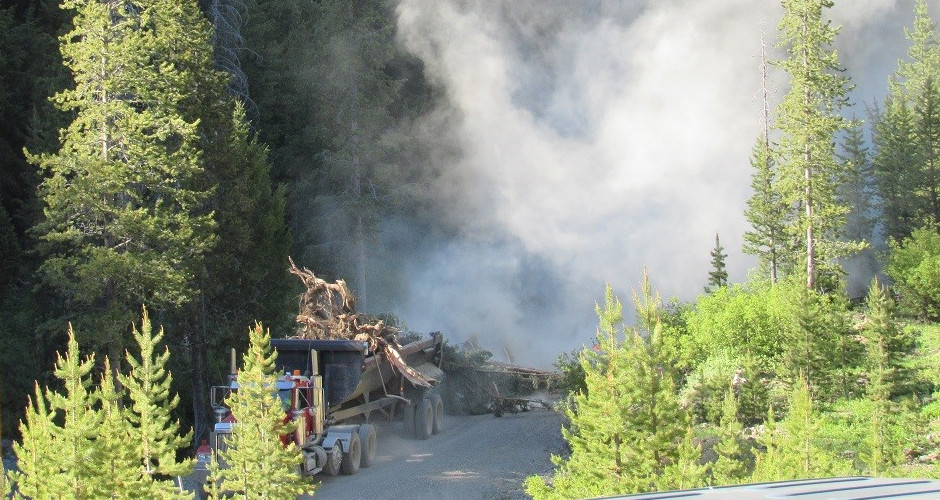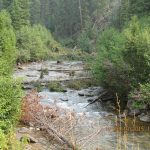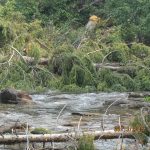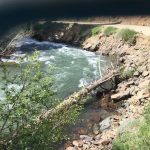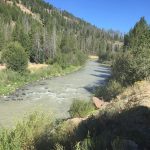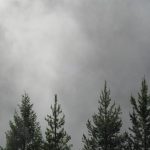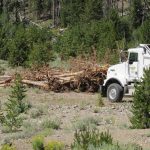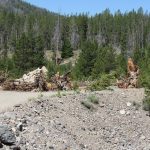My fish story begins as a boy with a willow pole fishing the headwaters of Jordan Creek, a tributary of the Yankee Fork of the Salmon River. With only rudimentary gear, I’d catch my limit of native cutthroat within a quarter mile from camp dipping holes and pulling pan size keepers. Not today however and not for quite some time has anyone bagged a limit of trout of any variety on Jordan Creek. Some blame the miners, I say phooey. There were more fish when there were more miners and fewer Bull Trout.
During the summer of 1989, I filed an operation plan with the USFS to mine gold bearing gravels on an ancient stream terrace above the existing Jordan Creek. At that time, the Idaho Fish and Game was trying to rid Idaho’s streams of Bull Trout because of their predatory nature. By 1992 the Bull Trout was gaining status as a fish to be protected. Sometime about 1998 the Bull Trout became protected and fishing up Jordan Creek and the Yankee Fork began to become less productive. By no means was the protection of the Bull Trout the end of the fish story, rather the beginning.
Money came pouring in from numerous sources to attempt to solve the loss of native trout in the 1990’s. Many stones were turned and diversions made in the quest to promote better aquatic habitat up the Yankee Fork. The Shoshone/Bannock tribes took the lead and continue to this day counting and recording salmon runs. For the past few years, however, there’s a new outfit in wading boots stomping up and down the Yankee Fork. Trout Unlimited has been funded with millions of tax and utility rate payer dollars tapping the politically correct and very lucrative habitat restoration industry. Most of the Yankee Fork project costs are unknowingly funded by Bonneville Power Administration rate payers and the US Fish & Wildlife Services through grants to the Idaho Department of Species Conservation. Trout Unlimited’s bid for the Yankee Fork restoration project has tasked them to restore reaches of the Yankee Fork that were carved up by J.R. Simplot’s gold dredge in the 40’s and 50’s. The proposed rehabilitation seems a thoughtful idea to the unfamiliar urbanite but a plan sure to fail for the those in the know. Turning piles of gravel left behind by Simplots’s dredging operation into a meandering stream where eddies and deep pools can feed and breed a revived population of native trout is by no means an easy task. Paramount to success for this daunting venture is good science, good engineering and the know how to put it all to useful practice. Understanding all the natural and human conditions affected are necessary for a successful outcome.
With single focus on trout rehabilitation, the necessities of man and the rest of the eco-system have been left without concern or advocacy. For example, for many years beavers have enjoyed damming the feeder stream constructed by the tribes to feed trout rearing ponds downstream. I’m sure their confounding activities weren’t part of the reclamation plan but beavers do what beavers do and as nature obliges they dammed up the streams. The havoc created in the newly renovated wetland sort of made me smile inside. Environmental sciences just haven’t caught up with nature and her constant vexing property of mucking up the most fail-proof engineering designs.
In recent years, Trout Unlimited upgraded the old wetland design with appurtenances that would surely find favor within the environmental academic community. The beaver, however, were not so impressed and packed up for less encumbered reaches of the Yankee Fork. Most found their new homes about a mile away up Jordan Creek. I guess if you’re going to make an omelet you’ve got to crack a few eggs and if you’re making a wetland for fish habitat a few displaced beaver are small price to pay. Try explaining that to the beaver.
The stream “upgrades” continue today. In 2015 live trees were placed up and down the Yankee Fork, root ball and all in apparent strategic localities to aid whatever fish habitat seems to be lacking. The new scientifically prescribed habitat of the day is on full display for those who wish to have a look. The now dead trees, root balls still attached, that were placed along the stream bank have washed down river during the high-water spring runoff. With all their supposed know-how, Trout Unlimited didn’t see that one coming. Some of the trees have now positioned themselves in such a way that the once stable stream bank is eroding the gravel road above. I suspect county residents will be saddled with the costs to fix that one as Money Unlimited’s multi-million-dollar budget has likely been specifically ear-marked.
Some of the trees have bunched up where the stream widens and slows and some have snagged other trees that were placed in just the right spot for superior enhancement of the trout fishery. I’m not sure who in their right mind would place large logs jutting out into the river just to make a rat’s nest of debris that comes down every year in high water. The unsightly piles of refuse also pose a hazard to any would-be floater who’s out for a fun day on the river. Nothing like being sucked under the current and held there at the mercy of a wayward tree branch to give you that outdoor experience many come to get. Lucky too that the bridges along the Yankee Fork weren’t washed away during high water from the now abundant man-placed log jams. Ask any local about the great run-off of 1974 and the bridges that were washed out without the aid of additional debris.
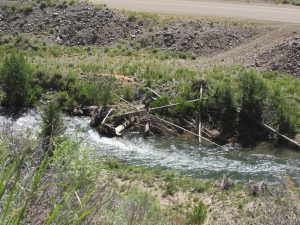
Typical Snag design along the Yankee Fork (notice large tree with root ball holding it all up)
Seems to me the whole live tree with root ball attached idea wasn’t well thought out. Why live trees anyway, it’s plain to see that half the forest is full of dead trees from beetle kill which would be better suited for this effort. This entire project seems to miss the mark on what is really needed which is live trees growing along the riverbank to provide shade and help reduce water temperature. To make the whole mess even messier imagine plucking these live trees from the ground and placing them in the river with a helicopter. Yes, that’s right, if you are running ahead of budget one of the best ways to blow a few hundred thousand dollars is to hire a helicopter to do what a skidder would easily do for $40/hr. Remember it’s tax dollars and rate payer dollars so it’s not like it is real money.
The river enhancement project up the West Fork of the Yankee Fork has also met with a few boo boos that would have sent any placer miner to prison. Don’t know how but the river ran full of mud for at least two days last August 10th & 11th. I didn’t hear cries of doom from US Fish & Wildlife Service, Idaho Fish & Game, the Army Corps of Engineers, Idaho Department of Environmental Quality, the Shoshone Bannock Tribes, Idaho Water Resources, the U.S. Forest Service or Western Watersheds or Trout Unlimited (who are known for their screaming lawyers when others do the same). The fiasco would surely have made headlines if some wayward miner let go a tailings pond spill (that happened in Colorado on the Animas River at a mine tailings pond but this was done by the EPA so no harm, no foul there either). It appears that the double standard of two sets of rules apparently apply to two different groups regarding the same sensitive environs. I’m of course under the more restrictive set that would likely have put me at great economic jeopardy, maybe even have led to a few years in the slammer.
Let me bring you up to speed on the current events of this year’s dynamic calamity. In the distance, it appeared as if Mt. St. Helens had erupted. A dust cloud began to billow up over the trees and mountain sides eventually overtaking the horizon on the upper reaches of Jordan Creek where I live. The chaos was created by a large diesel transport dragging a 120 foot once live pine with root ball attached. Wow, what a dust up, but for what I wondered? No way a logging company would get away with such irresponsible methods.
Not just a single 36″ diameter pine came scrubbing down the road but many. After several successive passes the road bed was scraped clean. Those small particles that bind the gravel base had all gone airborne. Each scrubbing pass put additional particles into the atmosphere turning up sharp stones for tires to chew and spit. Not a pretty sight and certainly not something any old dragster would get away with. After seeing the plume invade every crevice and cranny of our cabin (my wife pointed to the mucky velvet dusting across her counter tops, I knew the time for action was at hand). We followed the nonchalant culprit downstream to his final destination. There we found we were not the only people fascinated with the billowing attraction. Several cars were pulled over on the side of the road taking photos of this belching bronco. Bet they were all commenting about those damn loggers. But these guys weren’t loggers, fact is loggers don’t drag their trees around by the root balls for miles at a time. Pity the epitaph left to the uninformed will be to blame those damn loggers, a double whammy for the absent victim all by the hand of the hapless environmentalists!
What to do with all these trees you may wonder. I can’t help but wonder myself. Word is Trout Unlimited is looking for 300 additional such sized trees for next year’s rehab. It’s hell to be a live tree in these parts when so many have paid the ultimate price of neglect. Untamed forest fires, beetle and moth kill have raised havoc in our once magnificent forest. All things uncommon before the great environmental movement of the ’80’s. Think about how many homes 300 large Pine and Douglas Fir could provide and the economic boon that would multiply their lasting legacy. Never thought I’d be one to chain myself in protest to a tree but the thought has crossed my mind. This is forest abuse on an order that overshadows any true logging operation. Where are those “tree huggers” from the spotted owl hysteria era of the 1980’s that kicked off the environmental movement now? Have dollars unlimited taken over instead?
I’m not disparaging those who work for or are contracted by Trout Unlimited, just their methods. I don’t believe their means justifies this end. I know many have a true commitment to enhancing trout habitat but all seem to be short on the facts of nature. Environmental stewardship isn’t a science of consensus or of political expedience. There are mountains of variables that react to every nuance of change in the forest. Some subtle, some like a sledge hammer. This is the one-dimensional sledge hammer approach.
In the playing field of federal and state regulation best to operate under cover of environmental purpose as they are quick to forgive as long as you donate to their organization. Seems that what’s good for the goose is not good for the gander when considering options for economic growth on forested lands. Makes me think that I’d be wise to start a movement to save the beaver. How about “Beaver Unlimited”, because we give a dam! Looking for funding ideas, anybody with me?
